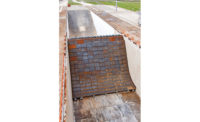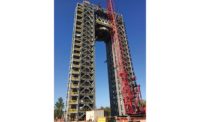NASA Space Launch System (SLS) Test Stands
Marshall Space Flight Center, Huntsville, Ala.
Best Project
Owner: U.S. Army Corps of Engineers-Mobile District
Lead Design Firm: Goodwyn Mills and Cawood/Merrick & Co. Joint Venture
General Contractor: Brasfield & Gorrie LLC
When NASA’s advanced Space Launch System (SLS) routinely propels human explorers to deep-space destinations at some future date, the vehicle’s powerful rocket engines will trace part of their evolution to a pair of specially constructed propulsion unit test stand structures at the Marshall Space Flight Center.
Known officially as Test Stands 4693 and 4697, the two new structures are designed to support rigorous evaluations of fuel tanks up to 149 ft long by simulating the pressures and stresses of launch and flight. The structures can also be reconfigured as new missions and technologies emerge. As such, both test stands required foundations with substantial amounts of reinforcing steel, anchoring components and mass placements of custom concrete pads.
For the 221-ft-tall Test Stand 4693, workers had to first dig into an existing test stand originally built for the Saturn V rocket to expose rebar 17 ft below grade that would form part of the new foundation. Crews then installed a total of 415 tons of new rebar and 420 tons of embedded steel frames to support two welded structural steel towers connected at the top with large roof trusses that support a 1-million-lb movable crosshead frame.
The foundation for the 97-ft tall L-shaped Test Stand 4697 consists of 263 12-in.-dia concrete-filled pipe piles, 295 tons of rebar and 346 tons of embedded steel frames.
According to Brasfield & Gorrie senior project manager Michael Tuggle, the most formidable foundation-related challenge may well have been installing hundreds of 14- and 6-ft anchor rods on 18 in. centers, “all of which had to be precisely set to match the test stand structures.”
Prefabrication proved essential in facilitating steel erection within a limited laydown area and in minimizing worker fall risks. Beginning with the uppermost section, the test stand towers were pre-assembled in seven tiers and stored until they were ready to be set in place. Similarly, Test Stand 4693’s massive movable crosshead—including its 200-ton center-mounted positioning hoist, catwalks and handrails—was assembled on four temporary strand jacks, each with a lifting capacity of 557 tons.
Appropriately for structures intended to validate components for safely transporting astronauts into space, safety underscored all aspects of the project, from controlled access and site-specific training to fully assessing work areas for unexploded ordinance left over from previous test programs. Tuggle says the “collaborative, overlapping safety oversight of the Corps, NASA and all contractors” paid off with zero lost-time incidents out of nearly a quarter-million work hours during 30 months of construction.
Related Article: Projects Shine With Construction Savvy








Post a comment to this article
Report Abusive Comment